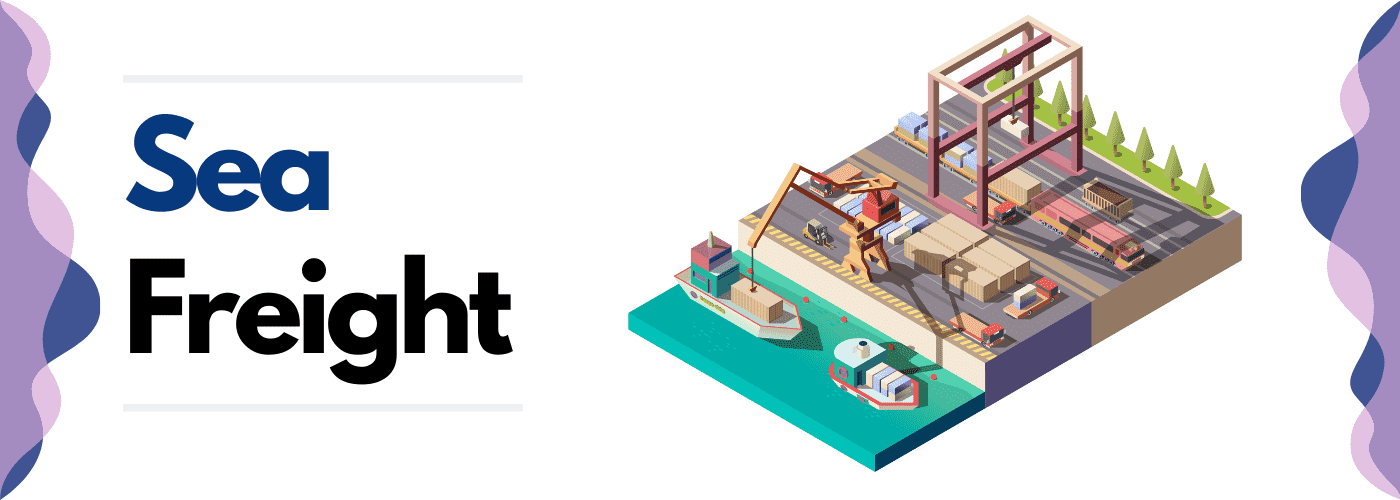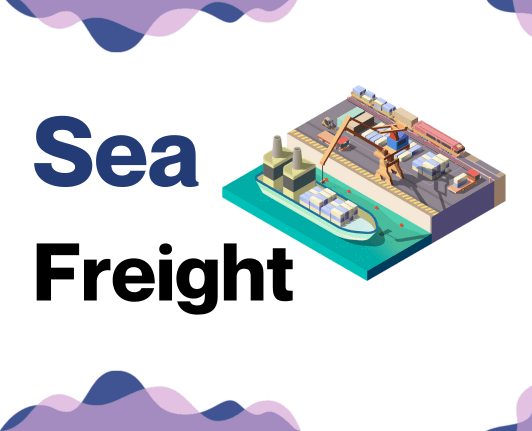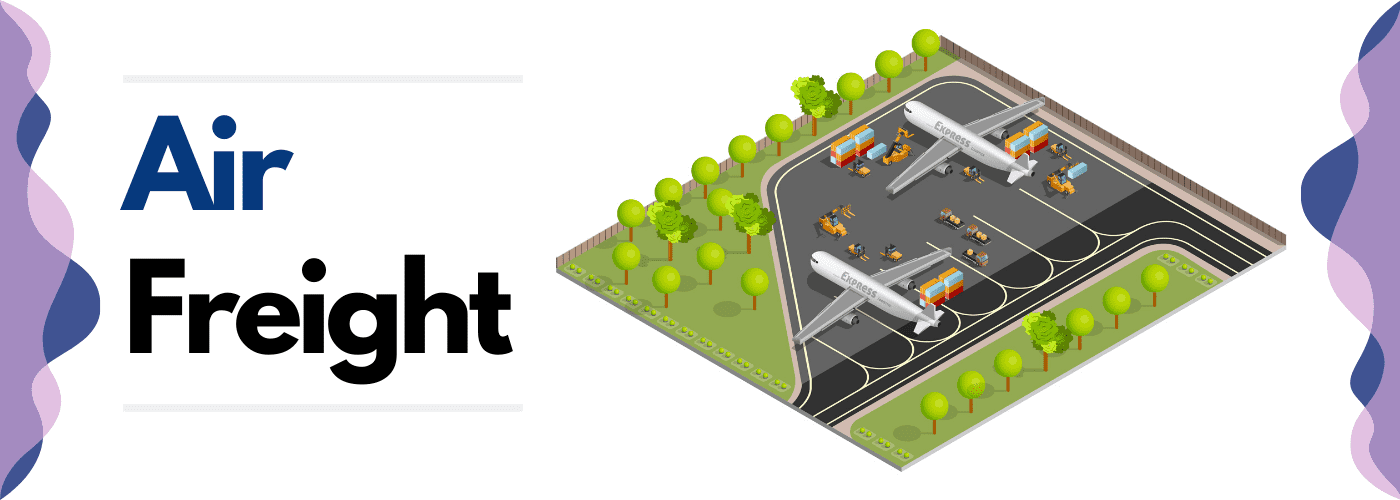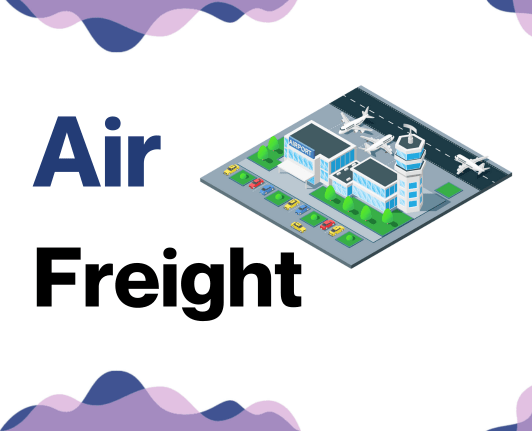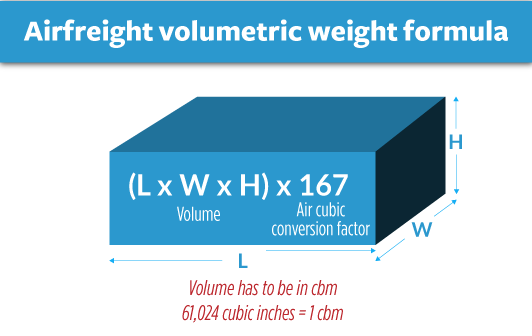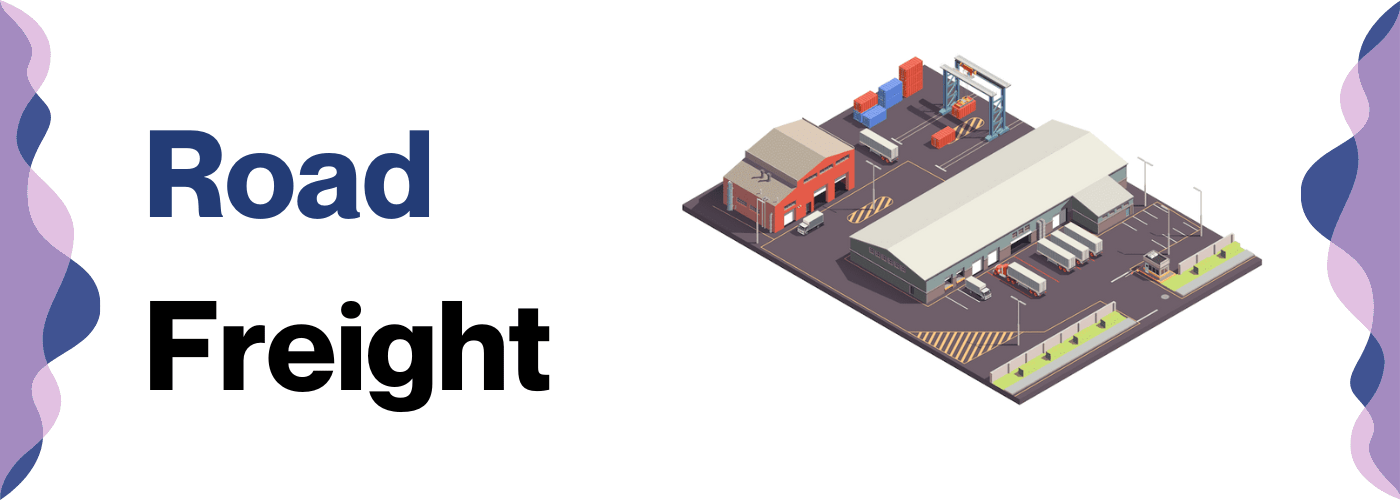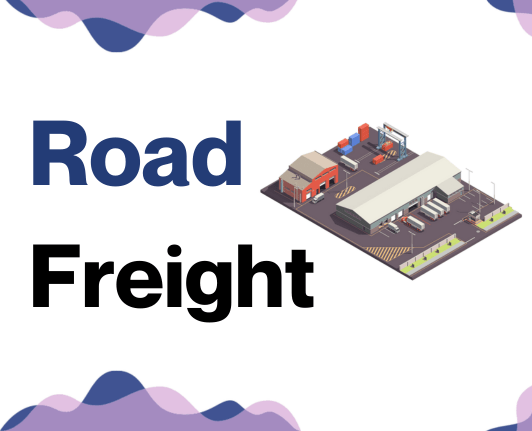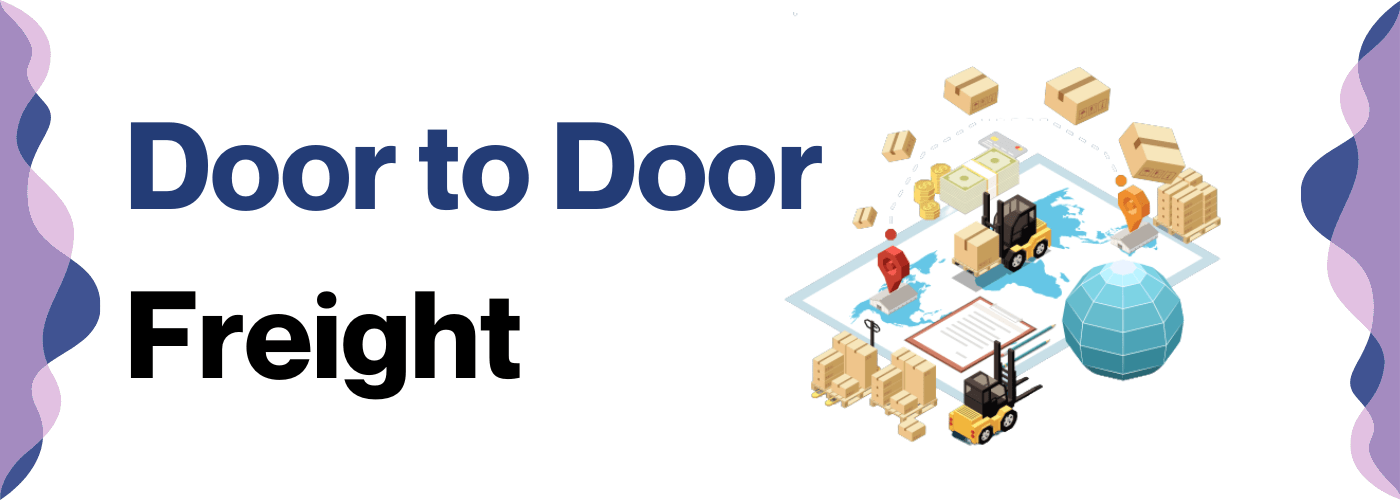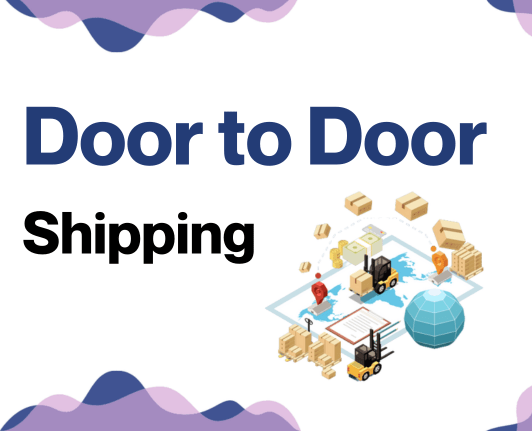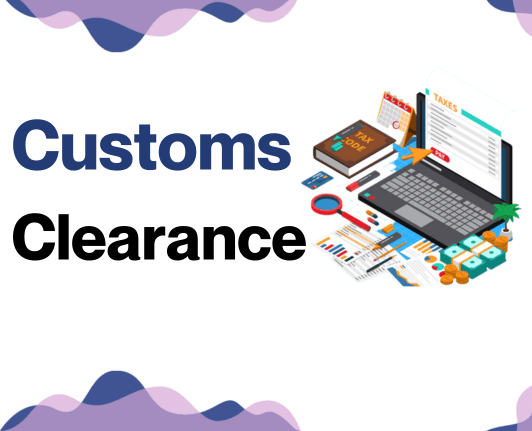Is your freight between the UK and Europe feeling like a tempermental pot of tea? Relax, you're not alone. The world of freight transport can often entail a labyrinth of rates, transit times, and customs regulations that can feel next to impossible to master.
But fear not, this guide is your lantern in the dark. It will illuminate the path through different types of freight options - whether by air, sea, road, or rail, and explain the real notion of customs clearance, duties, and taxes. We've tailored this guide specifically to meet the needs of businesses, with detailed information and key advice to make each shipping experience a breeze.
If the process still feels overwhelming, let DocShipper handle it for you! As an international freight forwarder, we manage every step of your shipping journey, making every hurdle a launching pad for your success.
Table of Contents
Which are the different modes of transportation between UK and Europe?
Deciding on the best way to move goodies between the UK and Europe is much like deciding the best route for your road trip.
Air and sea may seem like natural choices, given the little patch of water between them, but don't overlook the appeal of road and rail! With the tunnel connecting UK and mainland Europe, these options offer easy border crossings and can be faster for shorter distances.
But remember, the top choice always depends on your freight's size, urgency, and cost-effectiveness. Consider carefully, as each route has its own charm and challenges.
How can DocShipper help?
Stressed over shipping goods from the UK to Europe? DocShipper is here to soothe those worries. We simplify the complexities of international logistics, turning twists and turns into plain sailing. Ready to ship stress-free? Call us for a free consultation or get a detailed estimate within just 24 hours. Your seamless shipping solution is just a phone call away!
DocShipper Tip: Ocean freight might be the best solution for you if:
- You're dealing with large quantities or oversized items. Sea freight offers a budget-friendly way to maximize space, a particularly useful option given the UK's extensive port network.
- Your shipment isn't on a tight schedule. Ocean transport typically takes longer than air or rail, but it offers reliability.
- Your supply chain involves key ports, allowing you to take advantage of a wide-reaching network of sea lanes.
Sea freight between UK and Europe
With the bustling trade relationship between the UK and Europe constantly growing, it's no surprise that the high seas are a popular route for freight.
Bustling ports like Rotterdam in the Netherlands and Felixstowe in the UK serve as robust lifelines, connecting key industrial centers with a constant stream of goods. Ocean shipping, despite being the slowest method, becomes the sweet spot for those dealing with high-volume goods, thanks to its cost-effectiveness.
But let's not beat around the bush; shipping between UK and Europe can feel like maneuvering through one of London's infamous roundabouts: confusing and full of potential missteps. Common blunders range from misjudged delivery times to ignoring vessel options– each mistake proving costly. However, it doesn't have to be that complex. There are best practices and guidelines that can steer your goods safely across the sea, bypassing the common snares.
In this section, we will hoist the anchor and set sail into the nitty-gritty of these specifics, making your ocean shipping between the UK and Europe smoother than a sail on the Thames on a calm summer day.
Main shipping ports in UK
Port of Felixstowe
Location and Volume: Located in Suffolk on the North Sea coast, the Port of Felixstowe contributes to approximately 40% of the UK's containerized trade, handling over 4 million TEUs annually.
Key Trading Partners and Strategic Importance: Major trade partners include China, Continental Europe, and the USA, solidifying its status as the UK's busiest and most crucial port for container traffic.
Context for Businesses: If you're keen on capturing the European market while maintaining connections to Asia, the Port of Felixstowe's extensive network of trade routes and rail services can enhance your logistical efficiency.
Port of Southampton
Location and Volume: Situated on the South Coast, the Port of Southampton handles roughly 1.9 million TEUs a year, making it one of the key ports in the UK.
Key Trading Partners and Strategic Importance: It serves as a crucial gateway to Northern Europe, Far East, Indian Subcontinent, and North America.
Context for Businesses: If your operation involves the automotive industry, the Port of Southampton, being the hub of automotive transport in the UK, could play a pivotal role in your shipping strategy.
London Gateway
Location and Volume: Located on the River Thames's northern bank, London Gateway can handle up to 3.5 million TEUs annually.
Key Trading Partners and Strategic Importance: With key ties to Asia, Europe, and the Americas, it stands as one of the most technologically advanced deep-sea ports in the world.
Context for Businesses: If you seek to minimize overland transport costs and customs delays, the proximity of London Gateway to key UK markets, combined with its state-of-the-art facilities, can streamline your operations significantly.
Port of Liverpool
Location and Volume: The Port of Liverpool is located on the Mersey River Estuary and has the capacity to handle over 1 million TEUs annually.
Key Trading Partners and Strategic Importance: It provides connections to Ireland, Continental Europe, and the Americas, and is a principal port for trade with North Africa.
Context for Businesses: If you want to optimize routes for reaching Ireland and the west coast of the UK, the geographical advantage of the Port of Liverpool could help shorten transit times and reduce costs.
Port of Tilbury
Location and Volume: Port of Tilbury is located on the River Thames and is a significant multidisciplinary port, handling over 500,000 TEUs a year.
Key Trading Partners and Strategic Importance: It has essential trade links with Europe, Asia, and North and South America, standing as a cornerstone for construction and building materials.
Context for Businesses: If your business involves construction materials or perishables, this port's specialist terminals could be essential, enabling efficient import and export.
Port of Grimsby
Location and Volume: Located on the Humber estuary's south bank, the Port of Grimsby is predominantly a car import port but also services bulk cargo.
Key Trading Partners and Strategic Importance: Major trading partners include northern Europe and Scandinavia, making it strategically important for vehicle imports.
Context for Businesses: If you're in the automotive sector, specifically dealing with importing cars, the Port of Grimsby could be a central consideration for your shipping equation, given its car handling facilities.
Main shipping ports in Europe
Port of Rotterdam
Location and Volume: Located in the Netherlands, the Port of Rotterdam is the largest seaport in Europe, with a shipping volume of 438.8 million tonnes of cargo in 2023
Key Trading Partners and Strategic Importance: The port is key in trading with Asia, particularly China, and it forms the hub of the 'Port of Rotterdam - Rhine/Ruhr Area' transport axis serving Germany, Switzerland, and Austria.
Context for Businesses: If your business is considering reaching out to European markets, the Port of Rotterdam's triple-modal container terminals rail, road, inland shipping offer versatile logistics capabilities.
Port of Hamburg
Location and Volume: Located in Germany, the Port of Hamburg is the third largest port in Europe, boasting a shipping volume of 114.3 million TEUs in 2023.
Key Trading Partners and Strategic Importance: The port trades extensively with China, Russia, South Korea, and the USA, and serves as an important gateway to Northern and Eastern Europe.
Context for Businesses: The Port of Hamburg's superb infrastructure and connection to rail networks may benefit your business if it is focused on penetrating markets across Northern and Eastern Europe.
Port of Antwerp
Location and Volume: Situated in Belgium, the Port of Antwerp is the second largest in Europe, supporting a large shipping volume of approximately 12.5 million TEUs in 2023.
Key Trading Partners and Strategic Importance: It plays a crucial role in trading with many countries, mainly North America, Scandinavia, the UK, and India.
Context for Businesses: Ideal for businesses looking to scale in various markets, the Port of Antwerp's multimodal accessibility including the presence of Europe’s densest rail network provides a competitive advantage.
Port of Bremen
Location and Volume: Located in Germany, the Port of Bremen is one of the busiest ports in Europe, handling about 5.5 million TEUs in 2020.
Key Trading Partners and Strategic Importance: The port has significant trade activities with Asian markets, primarily China, along with the USA and Russia.
Context for Businesses: If your business is focused on robust growth, the state-of-the-art logistics services offered at the Port of Bremen and its access to the European railway network can be a tremendous resource.
Port of Valencia
Location and Volume: Situated in Spain, the Port of Valencia is the busiest container port in the Mediterranean, managing close to 7,236,365 tonnes of cargo in 2020.
Key Trading Partners and Strategic Importance: The port is a crucial player in trades with Iberian Peninsula countries, North Africa, and Latin America.
Context for Businesses: The Port of Valencia proves highly beneficial if you're targeting the Spanish, African, or Latin American markets, given its excellent hinterland connections.
Port of Felixstowe
Location and Volume: Located in the United Kingdom, the Port of Felixstowe is Britain's busiest container port, dealing with approximately 3.8 million TEUs in 2023.
Key Trading Partners and Strategic Importance: The port is pivotal for trade with Asian countries, specifically China, along with Europe and America.
Context for Businesses: If your business is targeting the UK markets or requires transshipment to other parts of the world, the Port of Felixstowe's high-frequency direct services to/from all major international ports could be beneficial.
Should I choose FCL or LCL when shipping between UK and Europe?
Imagine you're about to embark on a shipping adventure from the UK to Europe - your choice of transport method will determine your voyage's pace, price, and smoothness. Take a plunge into sea freight options: Full Container Load (FCL) or Less than Container Load (LCL), also known as consolidation. The decision should not be taken lightly - both alternatives have their merits, which can influence your shipping success considerably.
In this section, we'll dive into these options, making the differences crystal clear and steering you towards an informed decision that aptly fits your shipping needs. Let's set sail!
LCL: Less than Container Load
Definition:
LCL or Less Than Container Load is a method of shipping where your cargo doesn't fill a whole container and shares space with other shippers' goods. It's the equivalent of public transport for cargo.
When to Use:
LCL is ideal when your cargo is less than about 14 or 15 cubic meters (CBM). This is because it offers flexibility for lower volumes which might not be cost-effective to ship in a full container.
Example:
For instance, if you're a small business in the UK exporting artisanal cheeses to a gourmet store in France, your shipment might only occupy 8 CBM. Therefore, choosing an LCL shipment can help to share shipping costs with other businesses and save your resources.
Cost Implications:
As LCL freight combines multiple shippers' goods, it is typically more affordable for lower volume loads. However, it might consist of additional handling costs due to the consolidation and deconsolidation process. This choice also means your LCL shipping quote may change according to the fluctuation in the volume of goods being shipped alongside yours.
FCL: Full Container Load
Definition: Full Container Load (FCL) shipping is when an exporter or importer has exclusive rights to a container, typically of either 20'ft or 40'ft.
When to Use: If your cargo volume exceeds about 13/14/15 cubic meters, FCL shipping is often the most economical option. Aside from cost, FCL's safety factor might appeal to you as the container's seal remains intact from the UK to your European destination.
Example: Consider Company A, exporting machinery parts from Manchester to Paris. With a total of 15 CBM, going for FCL was wiser. They also had unique items, ensuring their safety with FCL was essential to avoid possible transit damage.
Cost Implications: Although the FCL shipping quote is usually higher compared to Less Container Load, it distributes over volume, resulting in a lower cost per unit. However, remember the charges for your FCL container don’t stop at the sea freight rate. Associated costs such as the cost of the container, transport to and from the port, and customs duties should be taken into account when considering the cost implications of FCL shipping.
Unlock hassle-free shipping
Struggling with the complexities of freight forwarding? Let DocShipper demystify the process. Our experts in ocean freight are ready to advise on whether consolidation or a full container is the best option for your unique needs. They factor in volume, frequency, and costs to define the best strategy for shipping between the UK and Europe. Ready to simplify your shipping? Reach out to us for a free estimation now.
How long does sea freight take between UK and Europe?
Sea freight between the UK and Europe typically takes around 1 to 7 days on average. However, transit times can vary depending on a variety of factors such as the specific ports used, the weight of the cargo, and the nature of the goods being transported.
For a more precise quote tailored to your specific needs, we recommend reaching out to a trusted freight forwarder such as DocShipper.
Here's a quick glimpse of the average transit times for sea freight between the main freight ports in both regions:
| UK Ports | Europe Ports | Average Transit Time (Days) |
| Port of Felixstowe | Port of Rotterdam | 1 |
| Port of Southampton | Port of Antwerp | 3 |
| Port of Liverpool | Port of Hamburg | 4 |
| Port of Tilbury | Port of Bremen | 1 |
*Please note, these are averages and actual times may vary. Always consider the unique circumstances of your cargo when planning your shipment.
How much does it cost to ship a container between UK and Europe?
Revolutionizing your business's global movement with hassle-free shipping from the UK to Europe can seem daunting, especially when deciphering the cost. Ocean freight rates and overall shipping costs per CBM typically span a broad spectrum.
The contributing factors? Everything from the Point of Loading to the Point of Destination, the carrier chosen, what you're actually shipping, and even monthly market fluctuations. Giving an exact figure is like hitting a moving target. But fear not, with our team of experienced shipping specialists, we're on hand to ease your worries and secure the best individualized rates.
Remember, we quote case-by-case, crafting the most cost-effective solution for your unique requirements. Expect the unexpected with us, but in a budget-friendly way!
Special transportation services
Out of Gauge (OOG) Container
Definition: An OOG container is specifically designed for out of gauge cargo that can't fit in a standard container due to its non-standard dimensions.
Suitable for: Cargo that exceeds the dimensions of a normal container such as large machinery, industrial goods, and oversized equipment.
Examples: Examples of OOG cargo could include wind turbines, construction machinery, and heavy plant equipment.
Why it might be the best choice for you: Given the large scale and non-standard sizes of your cargo, OOG containers provide flexibility in transporting larger items while retaining the benefits of container shipping such as protection from the elements.
Break Bulk
Definition: Break bulk is the shipping of cargo as separate pieces or units, uncontainerised, and not in trailers nor in bags.
Suitable for: Large items that due to their size, weight, and shape are not suitable for containerization.
Examples: Examples can include large turbines, construction equipment, transformers, etc.
Why it might be the best choice for you: If your products can't be easily containerized due to their shape or size, or if they're too heavy, then break bulk shipping could be a more efficient path for you.
Dry Bulk
Definition: Dry Bulk shipping involves the transportation of loose cargo load such as coal, grains, and minerals in large quantities.
Suitable for: Businesses that need to transport large volumes of loose, granular products.
Examples: These can include commodities such as grains, coal, iron ore, etc.
Why it might be the best choice for you: If you're dealing with large quantities of loose, granular commodities, dry bulk shipping would provide a cost-effective and efficient transportation method.
Roll-on/Roll-off (Ro-Ro)
Definition: Also known as Ro-Ro shipping, this refers to vessels designed to carry wheeled cargo such as cars, trucks, semi-trailer trucks, trailers, and railroad cars, that are driven on and off the ro-ro vessel.
Suitable for: Businesses involved in the logistics of motor cars, trucks, semi-trailer trucks, trailers, and railroad cars.
Examples: Common examples include cars, trucks, semi-trailers, caravans, and construction equipment with wheels.
Why it might be the best choice for you: If your cargo is mobile and can be driven on and off the ship, Ro-Ro shipping offers a convenient method of sea transport.
Reefer Containers
Definition: Reefer containers or refrigerated containers are used for goods which need to be transported at a constant temperature above or below freezing point.
Suitable for: Businesses shipping perishable items such as fruits, meat, fish, vegetables, dairy products, and pharmaceuticals.
Examples: Fresh fruits, seafood, frozen products, pharmaceuticals.
Why it might be the best choice for you: If your products require a regulated temperature to maintain their quality, then Reefer Containers would be your ideal solution.
To fully cater to your sea freight shipping needs from the UK to Europe, DocShipper provides extensive freight services and ensures they are tailored to your unique requirements. Feel free to contact us anytime and get a free shipping quote in less than 24 hours.
DocShipper Tip: Air freight might be the best solution for you if:
- You're facing tight deadlines or need rapid delivery. Air freight is your quickest option, which aligns well with the fast-paced business environment.
- Your shipment is relatively small, under 2 CBM. Air freight is ideal for these more compact loads.
- Your cargo's destination isn't easily reached via sea or rail. This makes air freight a viable option, especially given the extensive network of airports available.
Air freight between UK and Europe
Air freight between the UK and Europe is like a sprinter in a race - fast and reliable. It's the ideal choice for shipments that are small yet valuable, think of luxury goods, high-tech equipment or essential medical supplies.
But wait, there's more to air freight than just speed. It ensures the safest transportation, minimal handling and it importantly it adheres to a tight schedule, which means fewer worries for you about delayed shipments.
Despite these perks, shippers often trip up on crucial steps, like calculating the cost incorrectly. Picture this: you're baking a cake, but you've estimated the flour wrong. Result? A ruined cake. Similarly, the wrong shipping weight can inflate costs dramatically.
Also, overlooking air freight etiquette can burn a hole in your pocket. We hope to shine a light on these blind spots in our forthcoming sections.
Air Cargo vs Express Air Freight: How should I ship?
Ever wondered which air transport option best fits your UK to Europe business shipments?
In a nutshell, air cargo uses space in commercial airlines, while express air freight flies in dedicated planes, typically for urgent orders. We'll dive into the pros and cons of both, helping your business make an informed choice. Buckle in for this airway guide to ease your shipping woes!
Should I choose Air Cargo between UK and Europe?
Air cargo, harnessing major airlines such as British Airways Link and Air France-KLM Link, presents a cost-effective option. You'll find that it delivers good value for consignments exceeding 100/150 kg (220/330 lbs).
As a highly reliable means of transport, it ensures your freight arrives on schedule. Despite its longer transit times due to fixed schedules, air cargo may still align with your budget and meet your business priorities.
Should I choose Express Air Freight between UK and Europe?
Express air freight is a top-tier service for shipping smaller, time-sensitive cargo, leveraging dedicated cargo planes with no passengers. For cargo under 1 CBM or 100/150 kg (220/330 lbs), this could be your best choice.
Companies like FedEx, UPS, or DHL specialize in such deliveries, offering quick transportation between the UK and Europe. They expertly handle customs and delivery, saving time and reducing potential stress.
If your business values time more than cost, express air freight is worth considering. Despite higher rates, the convenience and speed it offers can outweigh the extra expense.
Main international airports in UK
Heathrow Airport
Cargo Volume: Annually manages around 1.7 million metric tons of cargo.
Key Trading Partners: United States, China, Germany, Hong Kong, Japan, and several others.
Strategic Importance: As the busiest airport in the UK, Heathrow is a gateway to Europe and the world, making it a crucial hub for international trade.
Notable Features: Operates around 80 airlines which connect to more than 180 destinations world-wide. It is equipped with extensive cargo handling facilities and storage areas.
For Your Business: Consider Heathrow if your business trades heavily with locations that are directly connected. Its extensive network and high cargo volume can accommodate various types of goods and provide fast transit times.
Manchester Airport
Cargo Volume: Handles more than 100,000 tons of import and export freight and mail annually.
Key Trading Partners: Primarily Europe, the Middle East, Asia, and the United States.
Strategic Importance: It's the largest airport outside of London, making it a significant gateway for Northern England.
Notable Features: Offers 210 destinations by more than 70 airlines. It possesses world-class cargo facilities with specialist services for different types of cargo.
For Your Business: If your company operates in Northern England or trades with its key partners, Manchester Airport might be the ideal choice to ensure low transportation cost and time.
Gatwick Airport
Cargo Volume: Manages more than 95,000 metric tons of cargo annually.
Key Trading Partners: Primarily Europe, United States, and Asia.
Strategic Importance: As the second largest airport after Heathrow, it provides robust connectivity to Europe and other continents.
Notable Features: Services by over 50 airlines to more than 200 destinations worldwide. Gatwick is known for its advanced cargo handling systems.
For Your Business: Investing in Gatwick could be advantageous if your business seeks broad coverage, particularly across Europe and needs advanced handling capabilities.
Stansted Airport
Cargo Volume: Ships more than 250,000 metric tons of cargo each year.
Key Trading Partners: Mainly Europe, Middle East, and USA.
Strategic Importance: Recognized as the UK's third-largest cargo airport, Stansted is notable for its extensive short and long-haul catchment areas.
Notable Features: Stansted is home to one of the largest freight hubs in the UK - the Stansted Cargo Terminal.
For Your Business: Stansted Airport might be the best choice for you if your business requires high-frequency express freight services, particularly to the European destinations.
East Midlands Airport
Cargo Volume: Approximately 365,000 metric tons of cargo are processed each year.
Key Trading Partners: Primarily Europe and North America.
Strategic Importance: Known as UK's primary pure freight airport, East Midlands is centrally located and is a key player in goods distribution across the UK.
Notable Features: Offers specialist courier and mail services. It is home to DHL's and UPS's main UK hubs.
For Your Business: If your business involves express courier services or next-day deliveries, East Midlands Airport's unique offerings might be exceptionally beneficial for you.
Main international airports in Europe
Frankfurt Airport
Cargo Volume: Frankfurt Airport boasts an annual cargo volume of 2.3 million tonnes, making it Europe's top cargo hub.
Key Trading Partners: Key trading partners include China, the US, and other major European nations.
Strategic Importance: Located centrally in Germany, Europe's largest economy, it links to major cities across the continent, providing significant strategic value for freight forwarding.
Notable Features: Frankfurt Airport accommodates more than 100 airlines, and its vast CargoCity area provides state-of-the-art logistics facilities.
For Your Business: If your business trades with Europe, using Frankfurt Airport allows your cargo to reach nearly every European country within hours, ensuring speedy delivery.
Paris Charles De Gaulle Airport
Cargo Volume: With an annual cargo volume of 2.2 million tonnes, the airport ranks as Europe's second-largest cargo airport.
Key Trading Partners: Trading partners include the US, China, and Middle Eastern countries.
Strategic Importance: The airport resides in France’s capital, a global commerce center, and links directly to the European rail network.
Notable Features: The airport houses a fully automated cargo terminal for maximum efficiency.
For Your Business: Utilizing this airport means you can leverage its extensive connections and automated systems to ensure timely and efficient transportation of goods.
Amsterdam Airport Schiphol
Cargo Volume: Amsterdam Airport Schiphol manages approximately 1.5 million tonnes of cargo annually.
Key Trading Partners: The main trading partners are the USA, Asia, and other European countries.
Strategic Importance: Schiphol is known as the gateway to Europe and is crucial for the Netherland's role in global logistics.
Notable Features: Schiphol boasts smart handling solutions, a dedicated cargo community, and eco-friendly options.
For Your Business: It could be a smart decision to use this airport if eco-friendly operations are crucial for your company or if you value access to Amsterdam’s leading flower and fresh produce markets.
London Heathrow Airport
Cargo Volume: Approximately 1.7 million tonnes of cargo pass through Heathrow annually.
Key Trading Partners: The US, China, and Japan are the airport's key trading partners.
Strategic Importance: As the UK's largest airport, Heathrow plays a vital role in importing and exporting goods and connects to over 180 destinations worldwide.
Notable Features: Heathrow has specialized precious goods handling and is about to undergo expansion.
For Your Business: Particularly if your business involves jewelries, valuable artifacts or sensitive documents, Heathrow’s specialized handling can provide peace of mind, not to mention its impressive global reach.
Leipzig/Halle Airport
Cargo Volume: Handling approximately 1.3 million tonnes of cargo per year, Leipzig/Halle operates as Europe's fifth largest cargo airport.
Key Trading Partners: Trading partners include major economies such as the US, China, and Russia.
Strategic Importance: Leipzig/Halle serves as the European hub for DHL and is considered Germany's cargo airport with the strongest growth rate.
Notable Features: The airport operates 24/7 and has excellent roadways and railway connections.
For Your Business: If your business requirements demand round-the-clock availability and services, Leipzig/Halle Airport is a practical option. It's ideal for high-volume or urgent shipping needs.
How long does air freight take between UK and Europe?
The average shipping time by air freight from the UK to Europe takes approximately 1 to 2 days. However, keep in mind that these durations can fluctuate depending on a variety of factors, including the specific airports involved, the weight and nature of the cargo. Consult with a freight forwarder like DocShipper to get an accurate estimate tailored to your specific shipping requirements.
How much does it cost to ship a parcel between UK and Europe with air freight?
Shipping an air freight parcel between the UK and Europe is subject to many variables that can impact costs, making a definitive price difficult to pin down. However, as a broad guide, you might expect rates to range between $2.5 - $5 per kg. Factors like distance to/from airports, parcel dimensions, weight, and nature of goods can significantly influence this.
You can trust our team to use their expertise to deliver the best rate for your specific needs, as we quote on a case-by-case basis. Contact us for a free, bespoke quote within 24 hours.
What is the difference between volumetric and gross weight?
Gross weight is simply the total weight of your shipment, including the product, packaging, and any other additions. On the other hand, volumetric weight is a measure that considers the overall size of a package - it factors in how much space your shipment occupies in the aircraft.
Air cargo companies calculate gross weight by just weighing the package in kilograms (kg). For volumetric weight, they measure the three dimensions of a package (length, width, and height) in centimeters, then apply a standard equation: Length (cm) x Width (cm) x Height (cm) / 6000 = Volumetric Weight (kg). In Express Air Freight services, which is usually for smaller shipments, the denominator is 5000 instead of 6000.
For example, let's say you need to ship a package that weighs 25kg. The box's dimensions are 50cm x 50cm x 60cm. In regular air cargo, the volumetric weight calculation would look like this: (50 cm x 50cm x 60 cm) / 6000 = 25kg. In lbs, that's 55.1 lbs. For Express Air Freight, the calculation goes: (50 cm x 50cm x 60 cm) / 5000 = 30kg, or 66.14 lbs.
Why does this matter? Because the cost of your shipment is based on either the gross weight or the volumetric weight, whichever is higher. This pricing system encourages businesses to pack their shipments efficiently, making good use of space, while keeping weight at a minimum. These dual calculations ensure you optimize your packing for cost-effective air shipping.
DocShipper tip: Road freight might be the best solution for you if:
- You're seeking a budget-friendly solution for shorter hauls. Road freight often comes out on top in terms of cost-effectiveness and speed for these kinds of distances.
- Your end destination is either within your own continent or just across the border. For such regional or intra-continental shipments, road freight is typically the most direct and rapid method.
- Your cargo has unique dimensions or shapes. The adaptability of trucking allows for a wide range of goods that may not conform to the size limitations of sea or air transport.
Trucking between UK and Europe
Exploring the highway to efficiency? You'll want to get familiar with cross-border trucking between the UK and Europe. With transit times considerably swift, well-established routes, and stable road conditions, it carves out its own niche in the freight world. It's a pocket-friendly option too when compared with its sea, air, and rail counterparts. But like every mode, it has its trade-offs. Road transport can be subject to congestion and weather conditions. Yet, the prospects of door-to-door delivery and less handling of goods make it a compelling choice for savvy businesses aiming for a no-fuss, cost-effective shipping solution.
What if I can’t fill a truck between UK and Europe?
As you scope out your shipping strategy between the UK and Europe, understanding the differences between Less than Truckload (LTL) and Full Truckload (FTL) freight options can make all the difference. It's about finding that sweet spot for your business where flexibility and cost-effectiveness intersect. Let's dive in!
LTL: Less than Truck Load
Less Than Truckload (LTL) is a cost-effective shipping method where your cargo shares space with other goods in the same vehicle. Imagine it like carpooling, but instead of people, you’re sharing space with other shippers' goods.
A perfect example would be, say you want to transport 10 CBM of craft beer from London to Paris. Instead of paying for a full truck (often around 60 CBM), with LTL, you only pay for the 10 CBM your beer occupies, while the rest of the space can be used by others. This makes the LTL shipment a budget-friendly solution if your freight doesn't fill an entire truck.
Wondering when to use LTL? Here's a short guide:
- Your cargo is less than 15 CBM.
- You're shipping multiple smaller consignments to various destinations.
- You want to keep costs low and delivery time is flexible.
- You’re aiming to reduce your carbon footprint as LTL loads mean fewer trucks on the road.
So, when your freight is in the threshold of 13 to 15 CBM, selecting LTL freight surely stands out as the smart choice.
FTL: Full Truck Load
Full Truck Load, commonly known as FTL freight, is a shipping option where your cargo takes up an entire truck. This method is ideal when the volume of your cargo is substantial, typically around 13, 14, or 15 cubic meters (CBM). This is easy to picture. Imagine you're shipping 500 standard boxes that are 0.03 CBM each from the UK to Europe; your total load would be 15 CBM. An FTL shipment would be the smarter choice since your cargo fills the truck, optimising costs and shipping time.
Here are some practical moments when FTL might be your go-to choice:
- When the cargo volume exceeds roughly 14 CBM, which is around the half capacity of a standard truck.
- If your shipment is high value or fragility risk, preferring a dedicated truck to reduce handling.
- When time is critical. With FTL, there's usually no stopping on the way to pick up other goods.
- If you have perishable goods requiring no stops and continuous refrigeration for the journey length.
Armed with this knowledge, you shouldn't find it difficult to decide between FTL and LTL for your specific shipping needs.
What are the main routes between UK and Europe?
The UK and Europe are interconnected through a network of efficient roadways. The most frequented routes include the vital M20 linking London to the Eurotunnel at Folkestone. It's a crucial link that ushers freight across the English Channel into mainland Europe. Other critical routes like the A20 extend to Dover Port, another significant hub for continental shipping.
Trans-European routes are no less vital. The E40 spans from Calais, France, through bustling hubs like Brussels, Belgium, and Frankfurt, Germany, eventually reaching Kyiv, Ukraine. Meanwhile, the E30 gives you access from Ireland to Russia, passing through cities like Amsterdam and Warsaw.
Each route has varied factors like toll fees, driving restrictions, and traffic volume that can affect transit times and costs, making careful planning a necessity in any freight journey.
What are the road transit times between UK and Europe?
Average road transport time between the UK and Europe ranges from a few hours to several days. However, accurately estimating the duration can be challenging due to unpredictable traffic, varying circulation rules, and sometimes less-than-ideal road conditions, like in Albania or Belarus. Remember, these are just average estimates; feel free to reach out to us for a cross-border freight quote within 24 hours.
How much does trucking cost between UK and Europe?
Determining the exact cost of truck freight between the UK and Europe is like guessing how many sweets are in the jar - not easy! Diverse factors like mileage, weight, and special requirements mean prices can fluctuate. But fear not, our team's got your back – we work hard to nab the top rates for your unique job. We're not into cookie-cutter quotes, but bespoke ones because each business is one of a kind, just like you!
DocShipper tip: Door to Door might be the best solution for you if:
- You prioritize ease and a hassle-free shipping experience. Door-to-door services manage the entire process, from collection to final delivery.
- You appreciate the efficiency of having one dedicated contact. With door-to-door, a single agent is responsible for overseeing all elements of your shipment.
- You want to limit the number of times your cargo is transferred. Door-to-door services minimize the switches between various transport methods, lowering the chances of damage or loss.
Door to door between UK and Europe
Navigating the world of international shipping? Let's demystify Door to Door shipping - a convenient service whizzing goods from a UK hub right to a doorstep across Europe. With tracing each step, sparing you customs fuss, and reducing delivery times as perks, it's a stellar option. Excited? Let's dive in!
Overview – Door to Door
Shipping between the UK and Europe can feel like a juggling act, but door to door services offer a streamlined cure. Imagine removing the stress of tracking multiple deliveries or drowning in paperwork; this all-in-one solution brings simplicity to your logistics, making it a favourite among DocShipper's clients.
Despite being a premium service, costs can outweigh the benefits for large, complex shipments. The ease, security, and reliability of having your goods delivered from the beginning to the end of their journey could just be the game-changer your business needs!
Why should I use a Door to Door service between UK and Europe?
Ever felt like that game of Tetris was a little too realistic when handling freight logistics? We feel you. Let's dissect why the Door to Door service between the U.K. and Europe could be your proverbial knight in shining armor.
1. Stressbuster: This service is like having an extra pair of hands—hands that deal with the entire journey of your goods. It collects your cargo—all shapes and sizes—from your doorstep and does all the tricky bits and pieces, right up until the final drop-off point, completely removing the pressure off your shoulders.
2. Tardiness Terminator: Freight scheduling, when under tight deadlines, can be nerve-wracking like that ticking countdown in an escape room. With Door to Door service, your goods are collected at a predetermined time and delivered with sharp punctuality. No more sleepless nights wondering about the whereabouts of your goods.
3. Specialized Caregiver: Think of your freight as that fragile China teacup—you wouldn't want just anyone to handle it, would you? Door to Door services handle complex cargo with kid gloves (not literally, of course), ensuring that your goods reach their destination in the same condition they were in when they left.
4. Convenience King: The prospect of having to figure out the trucking until the final destination would make anyone run a mile. With this service, however, it's like a virtual red carpet unrolling with each step—smooth sailing all the way.
5. One-Stop Solution: Consolidating responsibility reduces the risk of miscommunications. It's like having one personal assistant who knows the ins and outs of your needs, rather than adjusting to a new temp every day—more efficient and effective.
So there you have it! Five compelling reasons to think about Door to Door services. Remember, shipping is not (and especially shouldn't feel like) rocket science when you have the right partner facilitating your journey.
DocShipper – Door to Door specialist between UK and Europe
Ease your shipping concerns with DocShipper's comprehensive door-to-door service. Our adept team navigates every shipping path between the UK and Europe, handling packing, transport, customs, and every shipping method for you.
Benefit from the reassurance of a dedicated Account Executive, and our commitment to a stress-free experience. Be it a query or a request for a free estimate, our consultants are just a call away.
Rest assured, your goods are under the care of proficient experts at DocShipper, thereby delivering a seamless shipping journey from A to Z.
Customs clearance in Europe for goods imported from UK
Customs clearance refers to the legal procedures that allow goods into a country, under specific regulations and duties. When shipping from the UK to Europe, this process is intricate and laden with potential hidden costs. It's essential to consider diverse factors such as duties, taxes, quotas, and licenses or risk your products being held up at European borders.
Misunderstandings or miscalculations can result in unpleasant surprises such as additional bills or ceased goods. However, fear not! Over the next sections, we’ll unpack the intricacies surrounding this process. Whatever your shipment type or destination, DocShipper is ready to assist in streamlining your customs clearance.
It's as simple as contacting our team with the origin, value, and the HS code of your goods, and we'll help provide an estimate for your project. We tackle the complexity, so you don’t have to!
How to calculate duties & taxes when importing from UK to Europe?
Understanding how to estimate duties and taxes for imports from the UK to Europe can make your shipping process smoother and more predictable. You'll need some critical pieces of information to start calculating these costs robustly: the country where the goods originated, the Harmonized System (HS) code, the customs value (typically the cost of the goods, insurance, and freight value), the applicable tariff rate that corresponds to the product, and any additional taxes or fees that apply to the specific type of goods being imported.
Start your estimation by identifying the country where the goods you're importing were manufactured or produced. This factor plays a significant role in determining the applicable tariff rates and dictates the flow of the subsequent steps in the calculation process.
This initial identification sets the stage for estimating the customs duties, taxes, and additional fees that may apply to your goods as they travel from the UK to Europe.
Step 1 - Identify the Country of Origin
Knowing your product's origin is your compass when navigating import duties and taxes. So why is this so crucial? Here's five key reasons:
Firstly, trade agreements between the UK and the destination country in Europe can significantly lower or even exempt some customs duties. Secondly, understanding country-specific restrictions ensures you avoid complications at customs. Thirdly, some products have reduced tariffs if they're made primarily using materials sourced in the same country. Fourthly, identifying the country of origin helps protect your business from monetary losses due to non-compliance with regulations. Lastly, specific verification processes can be easier for goods coming from certain countries.
Here's a hot tip just for you: research existing trade agreements between the UK and your destination country. For instance, the UK-EU Trade and Cooperation Agreement places zero tariffs on most goods.
But beware each European country may have particular import restrictions. Some enforce higher standards, while others entirely prohibit certain goods. Your task? Familiarise yourself with these rules to ensure a smooth importing process. Yes, it’s tedious, but understanding the origin point will give you the upper hand.
Step 2 - Find the HS Code of your product
The Harmonized System (HS) Code is an international nomenclature for the classification of products, standardized for customs purposes. It allows you to classify commodities on a common basis, no matter where you're shipping. This intricate set of codes is your go-to guide when dealing with import or export matters, making you fluent in the universal language of trade.
Often, the easiest way to identify the HS code of your product is to consult the supplier. They are going to be familiar with what they're importing and should be attuned to all concomitant regulations.
In case that option is off the table, we're here to guide you through a simple process to hunt down that elusive HS code. An easily accessible resource for this type of search is the Harmonized Tariff Schedule.
Start by visiting the official USITC page by clicking here. In the search bar, type in the name of your product, then hit enter. Your eyes should then move to the Heading/Subheading column where you’ll discover the HS code of your product.
A word of caution though - It's critical to obtain an accurate HS Code. An incorrect code might stall your shipment, cause delays, and could even invite potential fines. Accuracy is king in this arena.
Lastly, understanding an HS code might be a bit daunting. So, for your convenience, here's an infographic illustrating how to read an HS code.
Remember, taking the time to ascertain the correct HS code is not only smart but promotes a smoother shipping process for you.
Step 3 - Calculate the Customs Value
Unraveling customs value can be daunting, but understanding it is pivotal for smooth shipping. As the basis for calculating duties, it differs from product value – it's not just about how much you've paid for the goods. Customs value is the CIF value: Cost (your goods' price), Insurance, and Freight (the costs of shipping your goods internationally).
Let's flesh that out with an example. Suppose you've bought an item for $100 (Cost). The shipping charges came to $20 (Freight), and insurance cost you $10. Your Customs value would thus be $130 (CIF) – the sum of all these costs. It's this CIF value that determines the customs duties you'll need to satisfy – critical to know when importing from the UK to Europe.
Remember, knowledge is power. Understanding the customs value amplifies your control over shipping costs and puts you in the driver's seat!
Step 4 - Figure out the applicable Import Tariff
An import tariff is a tax imposed on goods transported across international borders. It's essential to identify the correct tariff for your items, as it determines the import costs that need to be paid at the destination country's customs. Each country or trade bloc, like the EU, has its unique set of tariffs, so what applies in Europe can be different than what applies in the UK.
In the UK, to find the correct tariff rate, you can use the Trade Tariff tool offered by the UK government. Simply follow these steps:
1. Visit the Trade Tariff: look up commodity codes, duty, and VAT rates page.
2. Enter the HS code for the product you're shipping, which was identified earlier, and put in the country of origin.
3. Note down the duty rates given for your product.
Let's consider a practical example. Suppose you're importing a mechanical watch from the UK with a HS code of 9102.91. The tool tells you that the import duty is 4.5%.
If your freight and insurance (CIF) costs amount to $1,000 USD, you'd multiply this amount by the import duty rate. Here's how you'd do it:
Import Duty = CIF cost Import duty rate
= $1,000 4.5/100
= $45
So, the import duties for your mechanical watches would be $45 USD. Keep in mind, these are all indicative numbers and the actual values might differ in real-world scenarios. Understanding the import tariffs associated with particular goods is key to establishing an effective shipping strategy and avoiding unexpected costs. It might seem complex at first glance, but step-by-step guidance and application methods like this can definitely simplify the task.
Step 5 - Consider other Import Duties and Taxes
Your shipment made the journey from the UK to Europe, but the final set of fees are looming at the horizon - the import duties and taxes. Apart from the basic tariff you'd normally encounter, certain items are subject to additional costs.
Let's take a fifteenth-century antique chair, for example. An excise duty could be charged for its high value, often determined as a percentage of the item's worth. This is an additional tax levied on high value or high-volume goods.
For products imported under certain conditions, anti-dumping taxes may apply. If you're importing steel from the UK, for instance, and the European Union deems it sold under its production cost, an anti-dumping tax may be imposed to maintain fair competition within the market.
However, the biggest piece of the pie is often the Value Added Tax (VAT). This is a consumption tax imposed on a product whenever value is added at each stage of the supply chain. For example, if the VAT rate is 20%, for a product valued at $100, you'll end up paying an extra $20.
Remember, these are just examples and actual rates may vary. Use accurate evaluations of your goods and customer rapport to mitigate unexpected financial obligations. This level of preparedness and adaptability will navigate you successfully through the complexities of international logistics.
Step 6 - Calculate the Customs Duties
In step 6, you'll unravel the math behind customs duties. The computation involves three potential components: customs value, VAT, and anti-dumping or other taxes. The customs value, primarily, is the cost of your goods plus transport and insurance, while VAT is a percentage of the customs value plus tariff.
Here's how it works in the real world:
Situation 1: Assume a $10,000 customs value with a 5% tariff. The duty equals $500 (5% of $10,000) and no VAT is involved.
Situation 2: For a goods value of $20,000 carrying both a 10% tariff and a 20% VAT, the customs duties equal $2,000, and the VAT is $4,400 (20% calculated over $22,000 sum of goods value and customs duty).
Situation 3: Assuming a customs value of $30,000, a 15% tariff, 20% VAT and 10% anti-dumping tax, the duties become $4,500, VAT: $7,000 (20% over $35,000), and anti-dumping taxes $3,500.
Worried about this financial jumble? At DocShipper, we take care of every detail of your customs clearance, anywhere around the globe. Our aim is to make sure you aren't overcharged. So why not get a free quote from us within 24 hours? Your peace of mind might be just a click away.
Does DocShipper charge customs fees?
Navigating the customs process can feel like a maze. We, at DocShipper, simplify this as your custom broker in the UK and Europe. We handle customs clearance and charge for this service, but importantly, customs duties and taxes are not part of our fee - those go straight to the government.
You are only responsible for paying what's been officially levied by customs, and we provide you with official receipts as evidence. This means total transparency, and no unexpected extra costs from us!
Contact Details for Customs Authorities
UK Customs
Official name: Her Majesty's Revenue and Customs (HMRC)
Official website: https://www.gov.uk/government
Europe Customs
Official name: European Union Directorate-General for Taxation and Customs Union
Official website: https://ec.europa.eu/
Required documents for customs clearance
Unsure about customs paperwork? Let's unravel the complexities together! We're diving into crucial documents such as the Bill of Lading, Packing List, Certificate of Origin, and Documents of Conformity (CE standard). You'll gain insights to help your business sail smoothly through customs, minus the headaches of untangling legislative jargon.
Bill of Lading
Navigating the sea of customs clearance between UK and Europe? The Bill of Lading is your lifebuoy. It's an official shipping document that smoothly sails your goods from the seller's hands to yours-marking that important handover. If you're in a hurry, opt for an electronic or telex release. It discards the need for physical documents and gets your shipment moving faster. When it comes to air cargo, the Air Waybill (AWB) plays the same role. Stay on top of these documents, maintain clarity on their significance, and your freight-forwarding journey becomes a breeze. Securities are just paperwork away.
Packing List
For successful shipping between the UK and Europe, your Packing List is a power player. Think of it as the ultimate identifier, detailing everything about your shipment - what it contains, the quantity, dimensions, etc. For example, say you're shipping 200 pairs of designer shoes from London to Paris.
The packing list will inform the customs authority that your shipment contains 200 pairs, their sizes, colour, and any other specifications. Careful now, one wrong detail could lead to delays or even seizure at the customs. Precision is key here, whether you're transporting via sea or air, the Packing List is a must-have. Treat it like your shipment's CV - accurate, concise, and comprehensive.
It's your responsibility as a business owner or freight forwarder to ensure this document is on point, to facilitate a smooth customs process. Make it your hallmark of a hassle-free shipment!
Commercial Invoice
Shipping goods between UK and Europe? Your commercial invoice is crucial and must be accurate. It should include the seller's and buyer's contact info, detailed description of your goods, HS codes, and the transaction's value - a miss here could delay delivery.
This document can be the difference between a smooth customs clearance or a pile-up of charges. Keep it consistent with other shipping documents like your packing list. Take time to verify and sign each invoice from end-to-end.
Remember - first impressions matter, even with customs! Pro tip: Regularly cross-check your goods' classification with the ever-updating customs tariffs, as inaccurate HS codes often trigger inspection delays. Navigate mindfully!
Certificate of Origin
Navigating the seas of international shipping between the UK and Europe can sometimes feel like a stormy voyage.
The Certificate of Origin (CoO) is your compass, guiding you through the complex customs clearance process. Like a birth certificate for your goods, the CoO states the goods' country of manufacture. For example, if you're exporting wooden furniture crafted in Britain, your CoO certifies that its origin is the UK. It can be a ticket to preferential customs duty rates, potentially crisscrossing those financial burdens off your list.
So always ensure this document is in your arsenal before you set sail on your shipping journey. It not only ensures smoother sailing through customs clearance, but could also save your business money. That's a winsome breeze you won't want to miss in your sails.
Certificate of Conformity (CE standard)
Sending goods from the UK to Europe? Your products might need a Certificate of Conformity (CE Standard). This isn't a guarantee of quality but a declaration that your product meets EU safety, health, and environmental requirements.
Ever heard about the FCC standard used in the US? Well, it's kind of the same. However, remember the UK has left the EU, introducing its own marking, the UKCA. If your goods are going to the UK market, be sure to check the requirements for the UKCA marking.
You can do so here: UKCA Marking Guidance. Keep in mind, understanding and complying with these regulations is key to seamless transportation of your goods. Don't overlook them!
Your EORI number (Economic Operator Registration Identification)
Opting for air or sea freight to ship goods between the UK and Europe? If yes, you'll need an EORI number as it's your passport in the logistics world. Your EORI number, an identifier unique to you or your company, is what lets customs track your imports and exports with ease.
It used to be an EU thing, but even post-Brexit, this little string of digits still plays its part. Getting registered is a fairly straightforward process, though critical to avoid delays at the border. Without it, your goods may be stuck in customs limbo, costing you time and money.
Let's make your shipping experience smoother by equipping your business with an EORI number.
Get Started with DocShipper
Moving goods between the UK and Europe can be a complex puzzle of customs paperwork. Breathe easy with DocShipper. Our custom-tailored services ensure smooth and efficient procedures at every step of the customs clearance process. Wait no more! Contact us now to get a free quote within less than 24 hours. Let us make your shipping experience seamless and stress-free.
Prohibited and Restricted items when importing into Europe
Understanding the complexities around importing into Europe can be puzzling - especially knowing what's off-limits. It's critical to be aware of prohibited and controlled goods to avoid legal hassles and delays on route. Let's demystify these items you can't ship, or have strict rules to follow.
Restricted Products
Pharmaceutical products: You have to apply for specific licenses from the European Medicine Agency (EMA) for most drugs.
Animal products: Importing and exporting goods of animal origin requires a special permit from the European Commission's Health and Food Safety department.
Dual-use goods: For products that can be used both for civilian and military purposes, a license from the European Commission's Trade department is necessary.
Cosmetics: You have to comply with regulations under the European Commission's Internal Market, Industry, Entrepreneurship, and SMEs department for cosmetic products.
Food products: Certain goods under this category may require applying for specific health certifications or licenses from local authorities or the European Food Safety Authority (EFSA).
Chemical substances: For certain chemicals or substances, you'll need to register with the European Chemical Agency (ECHA).
Waste: The transportation of waste requires a license issued by the European Environment Agency (EEA).
Prohibited products
- Narcotics and illegal drugs: This includes but is not limited to cocaine, heroin, marijuana, and other similar substances.
- Unlicensed weapons and explosives: All firearms, ammunition, or explosives not expressly permitted or licensed are banned.
- Endangered animals, plants or their derivatives: This includes ivory from elephants, rhino horns, or tiger skin rugs, among others.
- Goods infringing on intellectual property rights: Counterfeit goods, unauthorized copies of branded clothing, movies, music, and software.
- Obscene materials: Pornographic material and obscene content is forbidden.
- Certain species of fish: Entry of certain fish species that are not on the EU approved list is prohibited.
- Certain types of cheeses and meats: For instance, non-pasteurized cheeses and certain animal products from non-EU countries are not allowed.
- Unauthorized pharmaceuticals: Some medicine, unapproved generic drugs, or unauthorized health supplements are banned.
- Hazardous substances: This includes certain pesticides, hazardous waste, asbestos, and other dangerous substances.
- Cultural assets: Artwork, antiques, or other cultural items that are classified as national treasures cannot be exported unless a specific permit is granted.
It is always crucial to do thorough research or consult with a logistics expert when unsure about specific goods. Regulations may vary, and it is important to keep in mind that this list is not exhaustive.
Are there any trade agreements between UK and Europe
Yes, the UK and Europe have a significant Trade and Cooperation Agreement in place, following Brexit. This agreement helps avoid tariffs on most goods traded between these regions. However, businesses must discern if their products meet specific rules of origin to exploit these benefits.
Keep an eye on the forthcoming European Freight Corridor, planned between Ireland and Continental Europe via the UK, which can streamline your logistics operations in the future. It's crucial to stay updated on changes in these agreements to take full advantage of them.
UK - Europe trade and economic relationship
The UK and Europe have shared a complex yet critical trade history. Since joining the European Economic Community in 1973, the UK’s trading fortunes were inexorably tied to Europe. Key sectors like automotive and pharmaceuticals have seen immense growth due to their market access to Europe.
After Brexit in 2020, the trade dynamics underwent a significant shift, although both remain major trading partners. For instance, in 2023, the trade volume between the two-part was 5.4 billion British pounds.
By offering a historical perspective and current state-of-play, businesses can better navigate the opportunities and challenges in these trade corridors.
Your Next Step with DocShipper
Overwhelmed by the shipping maze between the UK and Europe? A flurry of paperwork, customs, duties – all daunting and time-consuming. But, you're in business, not logistics, right? DocShipper's experts streamline this intricate process, uncomplicating it for you. We're adept at swiftly cutting through the red tape, saving you time, stress, and cost. Want seamless shipping? Contact us now, and let's move your business forward together.
Additional logistics services
Unearth seamless end-to-end supply chain solutions with DocShipper. Experience hassle-free delivery, storage, packing, and insurance, all under one roof. Because when we say 'comprehensive', we mean every link in your logistics chain. Welcome to worry-free, world-class service.
Warehousing and storage
Finding the right warehousing solution can feel like wading through a shipping container maze. Maintaining ideal conditions, like nipping temperature, is crucial for certain goods - think lovely French wines or Belgian chocolates. Luckily, our world-class storage facilities are ready to handle your diverse needs. Uncork more details on our dedicated page: Warehousing.
Packaging and repackaging
When shipping from the UK to Europe, right packaging is essential to protect your goods from damage. For delicate items like glassware or large machinery, a skilled professional is indispensable. Consider a case where you ship bulk porcelain vases - proper cushioning and aligning in the package can save thousands in potential losses. Get your package perfect with our dedicated agents. Visit our dedicated page, Freight packaging, for more.
Cargo insurance
Secure your business commodities from mishaps in transit not covered by standard fire insurance. For instance, imagine a shipment of Spanish wines held up due to stormy weather at sea - regular coverage won't cut it. Cargo Insurance is your umbrella against mishaps from pick-up to final delivery. More intricate than fire insurance, it’s about prevention and covering rare mishaps. Stay assured, stay covered. For more info, check out our dedicated page: Cargo Insurance.
Supplier Management (Sourcing)
Looking to source materials from Asia or East Europe? DocShipper makes it seamless. We find trusted suppliers and manage the entire procurement cycle for you. From tackling language barriers to navigating local markets, your business needs are covered. Plus, with our expert guidance, the process is a no-sweat experience. Dive deeper by visiting our Sourcing Services page.
Personal effects shipping
Moving from the UK to Europe with precious items or bulky goods? You're in the right place! At DocShipper, we handle your cherished personal effects with the utmost care. Remember that antique armoire or family heirloom you're worried about? Don’t fret, we've got your back. More info on our dedicated page: Shipping Personal Belongings.
Quality Control
Quality inspections are your secret weapon for shipping between the UK and Europe. They catch production errors early, safeguarding your reputation and bottom line. Imagine finding a batch of designer lamps with faulty wiring before they hit UK outlets. Priceless, isn’t it? Remember, maintaining quality isn't a choice – it’s a need. Discover how we can ensure your products meet the high standards. More info on our dedicated page: Quality Inspection.
Product compliance services
Shipping goods between two locations? Ensuring product compliance to regulations is key. With our Product Compliance Services, your goods are put through rigorous lab tests for certification, ensuring they meet all destination regulations. Avoid mishaps and enjoy smooth, secure shipping. Find out how we make this possible on our Product Compliance Services page.
FAQ | For 1st-time importers between UK and Europe
What is the necessary paperwork during shipping between UK and Europe?
When arranging a shipment from the UK to Europe, we at DocShipper manage the critical paperwork including the bill of lading for sea freight or air waybill for air freight. Equally important are the documents you provide, specifically the packing list and the commercial invoice. Depending on the nature of your goods, there may be a need for additional documentation such as Material Safety Data Sheets (MSDS), certifications, etc. Rest assured, we'll guide you through the process and ensure the necessary requirements are met for a seamless shipping experience.
Do I need a customs broker while importing in Europe?
Yes, we would highly recommend using a customs broker when importing into Europe. Customs processes can be incredibly complex, requiring detailed documentation and specific protocols. As your customs broker, we at DocShipper handle the majority of these procedures for you. We represent your cargo at customs, ensuring that every detail is properly addressed and all paperwork is accurately completed. This not only simplifies the process for you, but it can also help prevent unexpected delays or complications. Trust us to manage the complexities of customs clearance, so you can focus on your business.
Can air freight be cheaper than sea freight between UK and Europe?
Providing a definitive comparison between air and sea freight costs from the UK to Europe is challenging due to varying factors like route, weight, and volume. However, if the cargo is less than 1.5 Cubic Meters or weighs less than 300 kg (660 lbs), air freight could potentially be a cost-effective option. Rest assured, we at DocShipper prioritize providing competitive transport solutions. Our dedicated account executives will work relentlessly to offer the most economically viable option tailored to your specific shipping needs.
Do I need to pay insurance while importing my goods to Europe?
While we never enforce it as an absolute requirement, we strongly advise securing insurance for your goods during transit. Importing goods to Europe without insurance is indeed possible. However, it leaves your business vulnerable to a multitude of risks including damage, theft, and loss during the shipping process. By investing in insurance, you safeguard your interests and ensure that any unforeseen incidents won't have a devastating impact on your business. It might seem like an additional expense, but it grants peace of mind which makes it an asset well worth considering.
What is the cheapest way to ship to Europe from UK?
For short distances such as from the UK to Europe, road freight is typically the most cost-effective option. We at DocShipper often suggest this method for its budget-friendly and reliable service. However, if timing is a priority, air freight, despite being more expensive, ensures faster delivery. Always keep in mind that the best shipping method depends on your specific needs and budget.
EXW, FOB, or CIF?
Choosing between EXW (Ex Works), FOB (Free on Board), or CIF (Cost, Insurance, and Freight) largely depends on your relationship with your supplier. However, the complexity of logistics often makes it beneficial to engage professional help. While suppliers may sell under EXW or FOB terms, they're not specialists in logistics. We, as your agent, can deftly handle not just the international freight but also the process at destination. Your supplier can focus on their core competency while we ensure smooth door-to-door service. Depend on us, at DocShipper, to manage the logistics seamlessly, irrespective of your supplier's terms.
Goods have arrived at my port in Europe, how do I get them delivered to the final destination?
If your goods have reached their European destination port under CIF/CFR incoterms, securing a customs broker or freight forwarder is crucial for terminal clearance, import charge payment, and final delivery. However, you can engage our DocShipper team under DAP incoterms to manage these procedures. Be sure to confirm the details with your designated account executive for clarification.
Does your quotation include all cost?
At DocShipper, we ensure our quotes include all costs, with the only exception of duties and taxes at the destination. We aim for transparency to avoid unwelcome surprises. You can always inquire with your dedicated account executive for an estimate of the duties and taxes you might have to cover on arrival.

